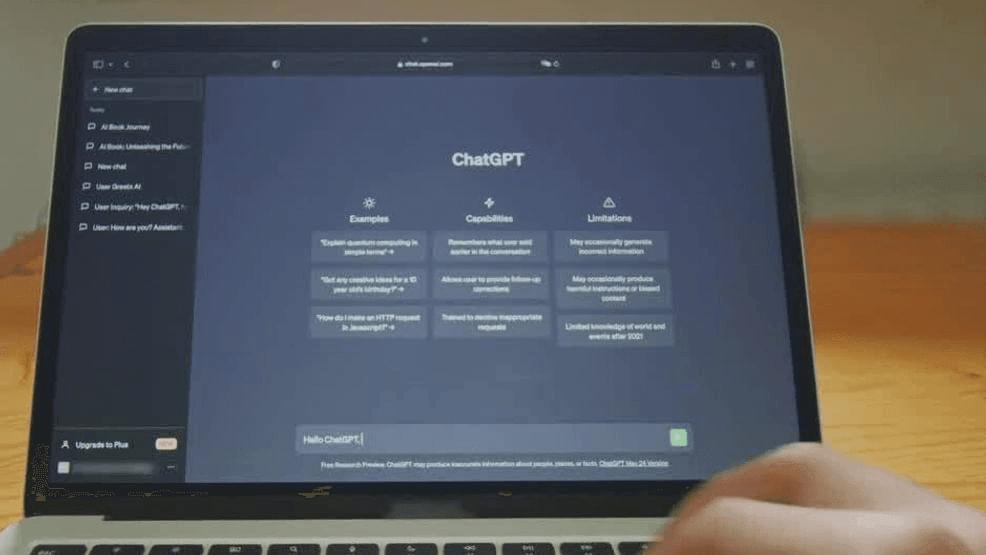Now that AI is invading classrooms and homework assignment, students need to learn reasoning more than ever


Artificial Intelligence isn’t science fiction anymore—it’s a transformative force shaping the way we live, work, and innovate. In this groundbreaking documentary, explore the real-world applications of AI as it evolves from code into conscious collaboration. From autonomous flying drones to lifelike androids, we uncover how AI is pushing the boundaries of possibility.
The Revolution Of AI (2020)
✍️ Writers: Kyle McCabe, Christopher Webb Young.
⭐ Stars: Shivani Bigler, Jason Derenick, Barbara Grosz.
🎞️ Genre: Documentary.
🌍 Country: United States.
🗣️ Language: English.
🎭 Also Known As: Hyper Intelligence.
📅 Release Date: 2020 (United States)
Synopsis:
Join leading experts and visionary engineers as they guide us through the cutting edge of AI technology. Discover how robotic drones are learning to think for themselves, navigating unknown terrain during high-risk rescue missions. See how swarm technology is revolutionizing farming, and how robots are teaming up with humans to increase safety and productivity at work.
Watch as scientists work toward the next big leap—robots with self-awareness. These advanced machines are learning to understand themselves, make decisions, and adapt to the world around them. With androids now capable of human-like interaction, the line between machine and man continues to blur.
Humanity Augmented | Science Documentary.
2077 — 10 Seconds to the Future — Mutation: https://youtu.be/qTkHD55kcaw.
With Augmented Humanity we will travel from the US to Japan, into the heart of secret labs of the most borderline scientists in the world, who try to push the boundaries of life through technology. Robotics is an important step, but the future of our species is not in a massive substitution by robots, on the contrary, robotics and technology must be used to improve the human being.
▬▬▬▬▬▬▬▬▬
Subscribe Free Documentary Channel for free: https://bit.ly/2YJ4XzQ
Instagram: https://instagram.com/free.documentary/
Facebook: https://bit.ly/2QfRxbG
Twitter: https://bit.ly/2QlwRiI
▬▬▬▬▬▬▬▬▬
#FreeDocumentary #Documentary #Augmented.
▬▬▬▬▬▬▬▬▬
Free Documentary is dedicated to bringing high-class documentaries to you on YouTube for free. With the latest camera equipment used by well-known filmmakers working for famous production studios. You will see fascinating shots from the deep seas and up in the air, capturing great stories and pictures from everything our beautiful and interesting planet has to offer.
Enjoy stories about nature, wildlife, culture, people, history and more to come.


“Disembodied Brains: Understanding our Intuitions on Human-Animal Neuro-Chimeras and Human Brain Organoids” by John H. Evans Book Link: https://amzn.to/40SSifF “Introduction to Organoid Intelligence: Lecture Notes on Computer Science” by Daniel Szelogowski Book Link: https://amzn.to/3Eqzf4C “The Emerging Field of Human Neural Organoids, Transplants, and Chimeras: Science, Ethics, and Governance” by The National Academy of Sciences, Engineering and Medicine Book Link: https://amzn.to/4hLR1Oe (Affiliate links: If you use these links to buy something, I may earn a commission at no extra cost to you.) Playlist: • Two AI’s Discuss: The Quantum Physics… The hosts explore the ethical and scientific implications of brain organoids and synthetic biological intelligence (SBI). Several sources discuss the potential for consciousness and sentience in these systems, prompting debate on their moral status and the need for ethical guidelines in research. A key focus is determining at what point, if any, brain organoids or SBI merit moral consideration similar to that afforded to humans or animals, influencing research limitations and regulations. The texts also examine the use of brain organoids as a replacement for animal testing in research, highlighting the potential benefits and challenges of this approach. Finally, the development of “Organoid Intelligence” (OI), combining organoids with AI, is presented as a promising but ethically complex frontier in biocomputing. Our sources discuss several types of brain organoids, which are 3D tissue cultures derived from human pluripotent stem cells (hPSCs) that self-organize to model features of the developing human brain. Here’s a brief overview: • Cerebral Organoids: This term is often used interchangeably with “brain organoids”. They are designed to model the human neocortex and can exhibit complex brain activity. These organoids can replicate the development of the brain in-vitro up to the mid-fetal period. • Cortical Organoids: These are a type of brain organoid specifically intended to model the human neocortex. They are formed of a single type of tissue and represent one important brain region. They have been shown to develop nerve tracts with functional output. • Whole-brain Organoids: These organoids are not developed with a specific focus, like the forebrain or cerebellum. They show electrical activity very similar to that of preterm infant brains. • Region-specific Organoids: These are designed to model specific regions of the brain such as the forebrain, midbrain, or hypothalamus. For example, midbrain-specific organoids can contain functional dopaminergic and neuromelanin-producing neurons. • Optic Vesicle-containing Brain Organoids (OVB-organoids): These organoids develop bilateral optic vesicles, which are light sensitive, and contain cellular components of a developing optic vesicle, including primitive corneal epithelial and lens-like cells, retinal pigment epithelia, retinal progenitor cells, axon-like projections, and electrically active neuronal networks. • Brain Assembloids: These are created when organoids from different parts of the brain are placed next to each other, forming links. • Brainspheres/Cortical Spheroids: These are simpler models that primarily resemble the developing in-vivo human prenatal brain, and are particularly useful for studying the cortex. Unlike brain organoids, they do not typically represent multiple brain regions. • Mini-brains: This term has been debunked in favor of the more accurate “brain organoid”. These various types of brain organoids offer diverse models for studying brain development, function, and disease. Researchers are also working to improve these models by incorporating features like vascularization and sensory input. #BrainOrganoids #organoid #Bioethics #OrganoidIntelligence #WetwareComputing #Sentience #ArtificialConsciousness #Neuroethics #AI #Biocomputing #NeuralNetworks #ConsciousnessResearch #PrecautionaryPrinciple #AnimalTestingAlternatives #ResearchEthics #EmergingTechnology #skeptic #podcast #synopsis #books #bookreview #ai #artificialintelligence #booktube #aigenerated #documentary #alternativeviews #aideepdive #science #hiddenhistory #futurism #videoessay #ethics


Australia has a maths problem. A new Grattan report shows that one in three Australian school students fail to achieve proficiency in maths.
The report, The Maths Guarantee: How to boost students’ learning in primary schools, shows that students from disadvantaged backgrounds struggle the most with maths. But one in five students from well-off families struggle too.
In a 2023 international maths test, only 13 per cent of our Year 4 students excelled, compared to 22 per cent in England and 49 per cent in Singapore.

Our minds are not hard-wired by age 18. They are changeable through our lives. Hear from people whose brains have changed to overcome disabilities.
Find us on social media!
X: https://ow.ly/FZBj50StcJb.
FB: https://ow.ly/1J7y50StcFW
TikTok: https://ow.ly/XmLR50StcKY
X (formerly Twitter)
MagellanTV Documentaries (@MagellanTVDocs) on X
The premiere documentary streaming platform for the lifelong learners out there.
Log into Facebook.
Log into Facebook to start sharing and connecting with your friends, family, and people you know.